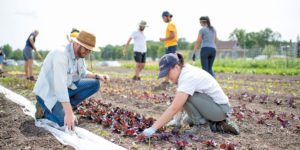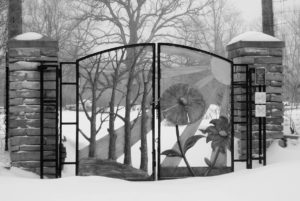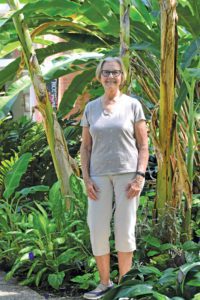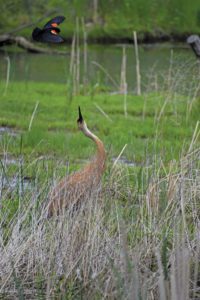Summer: plein air painters and farmer’s tans
Summer in the city can seem unrelenting, but on a sunny June day, scores of people are finding respite on the grounds of the U-M’s Matthaei Botanical Gardens off Dixboro Rd.
The layers of use are as abundant as the butterflies. Pete sits on the side patio under a coral umbrella. “I like to come scribble in my journal, take walks around the garden,” he says. “It’s sort of a meditational thing for me.”

Painting landscapes at the display gardens. | Photo: Sarah Royalty Pinkelman
Down the path in the display gardens, Leslie and Lynn set up easels to capture the bright orange butterfly weed. Lynn teaches at the Birmingham Art Center. Leslie is one of her students.
In the Children’s Garden, Evelyn and Kristen sit in the shade while their children play in the sand. Preschooler Sam is enjoying the dump truck.
An hour later, Kathleen and her students from Romulus Community Schools are having lunch on the patio after a “Water, Wetlands, and Watershed” program. They looked for animals in the pond, saw it undergo chemical testing, and learned observational skills.
Director Tony Kolenic, who took the job in March of 2021, describes the gardens as more of a museum than a park, intentionally curated to enable such varied days. He thinks in terms of creative placemaking, putting environmental, artistic, and cultural forces in play to enhance public engagement. Diverse partnerships, which allow room for multiple experiences and perspectives, are a key element.
One such partnership brought the U-M’s Campus Farm to the gardens’ grounds. Bob Grese, Kolenic’s predecessor, says it “grew out of students’ request to have a place where they could raise fruits and vegetables in a sustainable way.” Kolenic calls it “a vehicle for student leadership development, food justice, and sustainable food systems.”

Michigan Dining chefs check out crops at the Campus Garden. | Photo: E.Bronson/Michigan Photography
Student farmer Ivy Muench emails that “it’s satisfying knowing that we can handle” whatever comes up, thanks to the team’s “large set of skills.” And “walking around in a farmer’s tan and dirty jeans with a radio and knife sheath on my waistband, I have a sense of pride in looking like a farmer who is getting stuff done and knows what they are doing.”
Avery Logan, the farm’s produce sales manager, emails that it feels good “donating the food that I have personally grown by hand—from seed to product. I experience intense pride for the fields that have grown tall, strong, healthy, and ready to be harvested … I am also allowed the opportunity to see that beautiful food depart from the Campus Farm and be sent away—ready to be eaten.”
Kolenic adds that the Campus Farm partners with about six different social justice farms—places like Growing Hope—offering anything from hands to bench space to additional produce. They’ve recently begun working with the sovereign tribes of Michigan on two projects thus far. For the Heritage Seeds Project, Matthaei is planting seeds from the collection of the U-M Museum of Anthropological Archeology, collecting their seeds, and “rematriating” them to their ancestral keepers. The Mnomen Project aims to grow the “wild rice” of the Anishinaabek people in Willow Pond.
Another new partnership, with Jewish Family Services, offers garden plots for refugees. “Resettlement Garden is off to a great start,” Kolenic emails. Since launching in March 2022, “many new community members—largely from Afghanistan—are growing produce and making meaning there. The Resettlement Garden’s goals are simple: to provide a connection to place and to humanize what must be one of the most unmooring experiences through which people can go.”
It is this enlargement of community that Kolenic and colleagues strive for. “Our work right now is focused on increasing the density of meaning in each location,” he says, making the gardens’ spaces “deeply meaningful for as many communities as possible.”
The university has always ensured a free entry (though there’s a charge for parking), and as Kolenic and colleagues plan for repairing the wear and tear from increased use during the pandemic, they hope to increase accessibility in physical ways, considering such things as the “safety concerns of the angle of the crushed gravel” on paths and other improvements, he says.
Fall: studying ecosystems on the Graham Trail
Fall marks the tenth anniversary of the Campus Farm’s first harvest, and plans are underway for a big celebration. While students and staff celebrate at the farm, volunteer docent Greg Nowak might be at the front steps of the building to greet a school bus, or on a trail explaining the significance of the tannin smell coming from the autumn leaves under the students’ feet.
Fall offers “vivid examples of how living things adapt to their environment and interact together in complex relationships that form ecosystems,” Nowak says. The tours “provide an excellent hands-on experience which coordinates with their schoolwork.”
Nowak’s favorite trail is the Sam Graham Trees Trail. He emails that “its assortment of trees, plants, fungi, wildlife, and wildflowers, plus Fleming Creek” provides “opportunities to discuss how fungi and bacteria play key roles in the forest ecosystem circle of life.” And he always stops at Michigan’s state tree, the white pine: “I’ll pull down a branch, rub the soft needles on my face, and then let them touch the needles.” He enjoys the “sheer joy of discovery in their faces and voices” and the “surprise when we’re finishing a tour, and they learn that we’ve been at it for two hours.”
The grounds offer a plethora of hands-on learning opportunities for U-M students as well—the gardens originally reported to the biology department because of the botanical research. Eventually that authority transferred to the provost’s office, Grese says, and “our clientele was the whole university … We looked for any opportunities for collaborations across different units of the university, whether it be the College of Engineering … the School of Art and Design, College of Architecture, a variety of places.” This opened the door to installations testing building materials and other cross-discipline projects.
During Grese’s time, Matthaei and Nichols Arboretum were also merged into one organizational unit, bringing together administratively functions that once shared a physical space: the botanical gardens started out at the Arboretum in 1906.
They moved to the “Iroquois site,” near the present-day Woodbury Gardens Apartments and Townhouses off South Industrial in 1916. Then, in 1957, after Fred Matthaei Sr. (who became a regent in 1959) and his wife, Mildred, donated the land, U-M moved the gardens to the Dixboro site.
Many specimens were transplanted to the new conservatory there, curator David Michener emails, “including the two Cycas revoluta [sago palms], and—believe it or not—the lyrate ficus (in the left corner of the Tropical House as you enter) and the edible fig in the Temperate House. A good # in the desert house are very old.”
Winter: an ambassador at the conservatory

Winter brings its own beauty to the gardens’ outdoor spaces. | Photo: Mark O’Brien
While the outdoor field trips start to dwindle as the winter cold sharpens, visits for education and pleasure continue full throttle in the conservatory. These “huge greenhouses with main floor and overhead walkways,” Nowak says, are “divided into three separate ecosystems: tropical, temperate, and arid … [with] almost 1000 different types of plants and trees from around the world. In a matter of minutes, you can walk from a jungle through a Mediterranean temperate zone and into a desert featuring numerous varieties and sizes of cacti and succulents.”
You might also come across Carole Dubritsky, because winter is her big season at Matthaei. As a volunteer “conservatory ambassador,” she leads visitors through these meandering warm spaces after they’ve tramped through the Michigan snow to get inside.

“I think of it as a sacred space,” says volunteer conservatory ambassador Carole Dubritsky. | Photo: Sarah Royalty Pinkelman
“Ambassadors don’t have to have any background except an interest in the beauty of the space,” Dubritsky says. Decades ago, “I was a vocational rehab counselor for adults with disabilities … pre–Americans with Disabilities Act,” she explains. She loved her work, but it was challenging and she started pulling into Matthaei on her way home. “I turned off my radio and I opened my windows [and thought], ‘Oh, nice.’”
Later, as the U-M’s Americans with Disabilities Act coordinator, she worked with Grese to make the conservatory more accessible and became intrigued with the interior space as well. When she retired, those experiences made volunteering at Matthaei an easy choice.
She enjoys telling visitors from all over the world about vanilla being an orchid, the symbiotic relationship between an ant species and particular plant, and that the banana tree they’re admiring has been with the university for 100 years. But one of her most memorable experiences happened when a couple asked her, “where do you get your animals from?” She answered, “I’m sorry, but are you talking about the koi?” referring to the fish that inhabit the tropical-house water feature. But the couple took her to a leaf of the bird of paradise plant and pointed out a well-camouflaged gray tree frog. The visitor apparently got in through an open window and found the space welcoming.
Dubritsky still opens her car windows when she drives onto the grounds, even in the height of winter: “I think of it as a sacred space,” she says. “It’s a special place where I think people can find not just exploration and adventure [and] new things to know about, but also, calmness.”
Dubritsky’s involvement with the gardens runs deep—from workplace to meditation haven to educational volunteering, all with an accessibility awareness mindset.
Spring: minding the Massasaugua
As Dubritsky’s volunteer cycle at Matthaei winds down in spring, natural areas manager Steven Parrish is onboarding his summer interns. The U-M students will help him with the hard tasks of land management, particularly invasive plant species control.

Steven Parrish teaches his interns how to safely coexist with the gardens’ resident rattlesnakes. | Photo: Sarah Royalty Pinkelman
That intense and heavy work begins even before the interns arrive: “early spring, end of winter is when I will burn,” says Parrish, “because I know the snake is still hibernating. It’s got to be below 50 degrees” to avoid disturbing the Eastern Massasauga rattlesnake (EMR), an endangered species that inhabits the grounds of Matthaei and hibernates in its wetlands over winter.
The snakes will be up in the grasslands by the time the students arrive, so Parrish teaches the interns how to carefully and safely handle the EMR’s presence while they untangle invasive black swallow-wort vines and pull garlic mustard. Spring is an active time for the EMR, but it’s a quiet species that’s not eager for human interaction. With careful steps and attention, both intern and snake can coexist.

Migrating sandhill cranes and arriving red-winged blackbirds are welcomed each spring. | Photo: Sarah Royalty Pinkelman
In the spring, as Nowak’s field trips start ramping back up, Parrish is educating the Matthaei staff. He teaches a naturalist course every other week to the interns, and staff are invited as well. “Education is basically the solution to every problem we have,” he believes, “whether it’s ecological or world problems.” The interns carry this knowledge out into the world, one invasive species at a time.
Spring is also a time for preparation and anticipation of the year ahead. The Campus Farm starts their seeds for summer produce. The caretakers of the Children’s Garden take stock of how much sand they’ll need to add to the play area. And the EMR emerges from its hibernation and heads for the open fields.
Grese says he always enjoyed watching “the seasons change and winter turn to spring and then spring to summer … We all watched for the red-winged blackbirds to come back to some of the wetlands, and the sandhill cranes to come back through the property, and all of that was just really glorious.”
The depth of meaning that Kolenic seeks may come as much from what volunteers and visitors, animal and human alike, bring to the gardens as what the gardens themselves offer.

